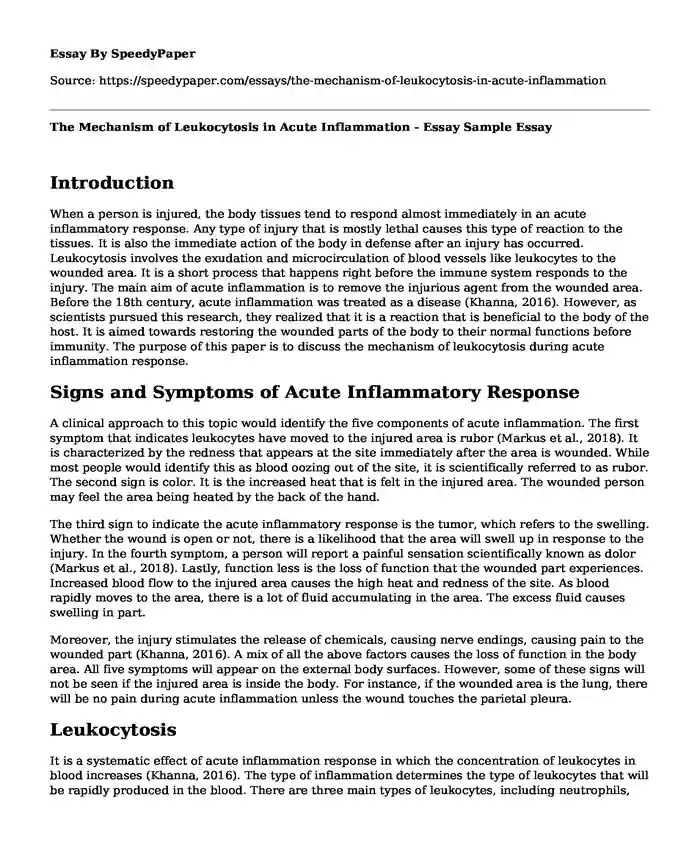Introduction
When a person is injured, the body tissues tend to respond almost immediately in an acute inflammatory response. Any type of injury that is mostly lethal causes this type of reaction to the tissues. It is also the immediate action of the body in defense after an injury has occurred. Leukocytosis involves the exudation and microcirculation of blood vessels like leukocytes to the wounded area. It is a short process that happens right before the immune system responds to the injury. The main aim of acute inflammation is to remove the injurious agent from the wounded area. Before the 18th century, acute inflammation was treated as a disease (Khanna, 2016). However, as scientists pursued this research, they realized that it is a reaction that is beneficial to the body of the host. It is aimed towards restoring the wounded parts of the body to their normal functions before immunity. The purpose of this paper is to discuss the mechanism of leukocytosis during acute inflammation response.
Signs and Symptoms of Acute Inflammatory Response
A clinical approach to this topic would identify the five components of acute inflammation. The first symptom that indicates leukocytes have moved to the injured area is rubor (Markus et al., 2018). It is characterized by the redness that appears at the site immediately after the area is wounded. While most people would identify this as blood oozing out of the site, it is scientifically referred to as rubor. The second sign is color. It is the increased heat that is felt in the injured area. The wounded person may feel the area being heated by the back of the hand.
The third sign to indicate the acute inflammatory response is the tumor, which refers to the swelling. Whether the wound is open or not, there is a likelihood that the area will swell up in response to the injury. In the fourth symptom, a person will report a painful sensation scientifically known as dolor (Markus et al., 2018). Lastly, function less is the loss of function that the wounded part experiences. Increased blood flow to the injured area causes the high heat and redness of the site. As blood rapidly moves to the area, there is a lot of fluid accumulating in the area. The excess fluid causes swelling in part.
Moreover, the injury stimulates the release of chemicals, causing nerve endings, causing pain to the wounded part (Khanna, 2016). A mix of all the above factors causes the loss of function in the body area. All five symptoms will appear on the external body surfaces. However, some of these signs will not be seen if the injured area is inside the body. For instance, if the wounded area is the lung, there will be no pain during acute inflammation unless the wound touches the parietal pleura.
Leukocytosis
It is a systematic effect of acute inflammation response in which the concentration of leukocytes in blood increases (Khanna, 2016). The type of inflammation determines the type of leukocytes that will be rapidly produced in the blood. There are three main types of leukocytes, including neutrophils, eosinophil, and monocytes. Monocytes cayuse a monocytosis reaction, eosinophil causes eosinophilia, while neutrophils cause neutrophilia. During acute inflammation, neutrophilia is caused by fungi, viral infections, and pyogenic bacteria. Therefore, during neutrophil leukocytosis, there is the occurrence of pyogenic diseases followed by the migration of neutrophil.
Blood vessels moving in the blood are hence depleted, and this causes neutropanaemia (Khanna, 2016). A counter-reaction occurs against pyogenic infections to respond to the process. A release of leukocytes from the bone marrow responds to the disease in a neutrophil leukocytosis (Markus et al., 2018). Specific cytokines catalyze the release of neutrophil leukocytes from the bone marrow or the hematopoietic tissues. They include colony-stimulating factors (CSFs) and IL-8, which are produced by macrophages to react to the presence of antigens.
The mechanism of leukocytosis occurs when pro-inflammatory cytokines are produced. The common cytokines in this process include CSFs, IL-8, IL-6, and IL-1 (Markus et al., 2018). The method may also have the elevation of chemokine in the blood vessels. It is the increased production and circulation of blood to the injured area. Bone marrow cells will also be activated in the process of releasing neutrophil components in response to antigens. Essentially, mature leukocytes will also be required to facilitate the restoration of function to affected areas.
During the mechanism of leukocytosis, a common feature occurs where neutrophil shifts from right to left. It involves the release of mature leukocytes to the blood. If the process is prolonged, the immature neutrophil may also be released to the bloodstream. In this case, the immature leukocytes that are also known as monocytes are divided into mature leukocytes. The process occurs when immature leukocytes react with CSF cytokines (Khanna, 2016). Neutrophil leukocytosis is the most common acute inflammatory response that occurs in response to pyogenic infections. However, eosinophil leukocytosis may also occur in response to parasitic infection. Finally, the type of leukocytosis mechanism is determined by infection or inflammation occurring in the body.
References
Markus, R. P., Fernandes, P. A., Kinker, G. S., da Silveira CruzMachado, S., & Marçola, M. (2018). Immunepineal axis–acute inflammatory responses coordinate melatonin synthesis by pinealocytes and phagocytes. British journal of pharmacology, 175(16), 3239-3250. https://bpspubs.onlinelibrary.wiley.com/doi/abs/10.1111/bph.14083
Khanna, G. (2016). Concise Pathology for Exam Preparation-E-BooK. Elsevier Health Sciences. https://accessphysiotherapy.mhmedical.com/content.aspx?bookid=333§ionid=40013175#40013682
Cite this page
The Mechanism of Leukocytosis in Acute Inflammation - Essay Sample. (2023, Dec 27). Retrieved from https://speedypaper.net/essays/the-mechanism-of-leukocytosis-in-acute-inflammation
Request Removal
If you are the original author of this essay and no longer wish to have it published on the SpeedyPaper website, please click below to request its removal:
Popular categories





